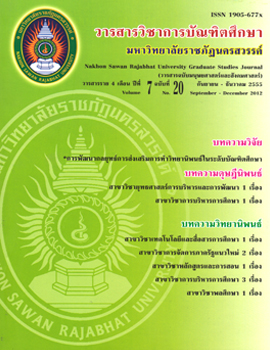สมรรถภาพทางกายเพื่อสุขภาพของนักเรียนชั้นมัธยมศึกษาตอนปลาย ในโรงเรียนมัธยมยอดนิยมเขตพื้นที่การศึกษามัธยมศึกษาเขต 16 จังหวัดสงขลา
Main Article Content
Abstract
บทคัดย่อ
งานวิจัยนี้มีวัตถุประสงค์เพื่อ 1) จำแนกระดับสมรรถภาพทางกายเพื่อสุขภาพของนักเรียนชั้นมัธยมศึกษา ตอนปลายในโรงเรียนมัธยมยอดนิยม เขตพื้นที่การศึกษามัธยมศึกษาเขต 16 จังหวัดสงขลา ตามเกณฑ์สมรรถภาพทางกายที่สัมพันธ์กับสุขภาพในเด็กอายุ 7–18 ปี ของกรมอนามัย และเกณฑ์มาตรฐานสมรรถภาพทางกายของกรมพลศึกษา และ 2) เปรียบเทียบสมรรถภาพทางกายเพื่อสุขภาพของนักเรียน ตามตัวแปรโรงเรียน เพศ ระดับชั้นเรียน และแนวการเรียน สุ่มตัวอย่างแบบแบ่งชั้น ได้กลุ่มตัวอย่าง จำนวน 393 คน รวมรวมข้อมูลด้วยแบบทดสอบสมรรถภาพทางกายที่สัมพันธ์กับสุขภาพในเด็กอายุ 7–18 ปี ของกรมอนามัย และแบบทดสอบสมรรถภาพทางกายของกรมพลศึกษา วิเคราะห์ข้อมูลด้วยโปรแกรมสำเร็จรูปทางสถิติเพื่อหาค่าเฉลี่ย ค่าเบี่ยงเบนมาตรฐาน และทดสอบสมติฐานด้วยการวิเคราะห์ความแปรปรวน
ผลการวิจัย พบว่า
1. นักเรียนชาย และนักเรียนหญิงชั้นมัธยมศึกษาปีที่ 4,5 และ 6 มีสมรรถภาพทางกายเพื่อสุขภาพทุกด้าน ระดับปานกลาง ส่วนนักเรียนหญิงชั้นมัธยมศึกษาปีที่ 6 มีสมรรถภาพทางกายเพื่อสุขภาพด้านดันพื้น 1 นาที ระดับระดับต่ำ และนักเรียนหญิงชั้นมัธยมศึกษาปีที่ 5 และ 6 มีสมรรถภาพทางกายเพื่อสุขภาพด้านเดิน/วิ่ง 1.6 กิโลเมตร ระดับต่ำมาก
2. ผลการเปรียบเทียบสมรรถภาพทางกายเพื่อสุขภาพ ตามตัวแปรโรงเรียน เพศ ระดับชั้น และแนวการเรียน พบว่า นักเรียนที่สังกัดโรงเรียนต่างกันมีสมรรถภาพทางกายเพื่อสุขภาพ ด้านนั่งงอตัว ลุก-นั่ง 30 วินาที ดันพื้น 1 นาที และเดิน/วิ่ง 1.6 กิโลเมตร แตกต่างกันอย่างมีนัยสำคัญทางสถิติระดับ.05 นักเรียนเพศชายและเพศหญิงมีสมรรถภาพทางกายเพื่อสุขภาพด้านลุก-นั่ง 30 วินาที ดันพื้น 1 นาที และเดิน/วิ่ง 1.6 กิโลเมตร แตกต่างอย่างมีนัยสำคัญทางสถิติระดับ.05 นักเรียนที่ระดับชั้นเรียนต่างกันมีสมรรถภาพทางกายเพื่อสุขภาพด้านการนั่งงอตัว และการเดิน/วิ่ง 1.6 กิโลเมตร แตกต่างกันอย่างมีนัยสำคัญทางสถิติที่ระดับ.05 และนักเรียนที่มีแนวการเรียนต่างกันมีสมรรถภาพทางกายเพื่อสุขภาพด้านดัชนีมวลกาย ลุก-นั่ง 30 วินาทีและเดิน/วิ่ง1.6 กิโลเมตร แตกต่างกันอย่างมีนัยสำคัญทางสถิติที่ระดับ.05
Abstract
The purposes of this research were 1) to classify the level of health-related physical fitness of upper secondary school students in popular schools of the Secondary Education Service Area 16 Province of Songkhla by health-related physical fitness standard of children age 7-18 years old of Health Department and physical fitness standard of Department of Physical Education, and 2) to compare health-related physical fitness of upper secondary school students in popular schools of the Secondary Education Service Area 16, Province of Songkhla. Three variables were schools, genders, levels and departments. The samples used were 393 students selected by stratified random sampling. The research tools were the test of health-related physical fitness standard of children age 7-18 years old of Health Department and the test of physical fitness standard of Department of Physical Education. The data were analyzed by computer program to calculate the means and standard deviation. The hypothesis was tested by variation.
The research found that both male and female students of Mattayom 4, 5 and 6 had overall health-related physical fitness at a medium level. For female students in a minute-push-up of Mattayom 6 was very low and in 1.6-kilometre-walk/run of Mattayom 5 and 6 was very low. The comparison result of health-related physical fitness according to schools, genders, levels and departments found that students in different schools had health-related physical fitness in trunk flexion, 30-second-sit-ups, a minute-push-up and 1.6-kilometre-walk/run differently at the statistically significant level of .05. Different gender students had health-related physical fitness in 30-second-sit-ups, a minute-push-up and 1.6-kilometre-walk/run differently at the statistically significant level of .05. Students of different class level had health-related physical fitness in trunk flexion and 1.6-kilometre-walk/run differently at the statistically significant level of .05. Students of different department had health-related physical fitness in physical index, 30-second-sit-ups, and 1.6-kilometre-walk/run differently at the statistically significant level of .05.


